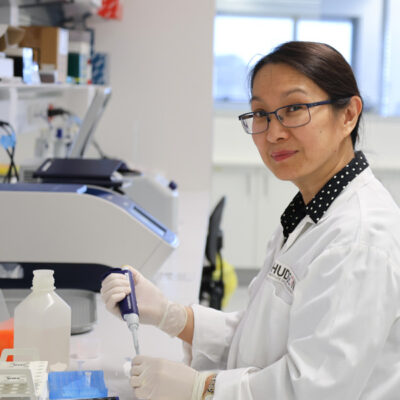Research uncovers clues to cause of endometriosis
By Hudson Institute communications
Scientists are one step closer to understanding the cause of the debilitating condition endometriosis, following the completion of a study into cells found in the lining of the womb called the endometrium.

In the study, published in the journal Human Reproduction, Professor Caroline Gargett and her team sought to determine whether regenerative cells called endometrial epithelial progenitor cells could be the initiator of the abnormal growth of cells in endometriosis lesions.
In examining endometrial samples from 102 women, with and without endometriosis, the team found that women with endometriosis had endometrial epithelial progenitor-like cells mixed with cells in the part of the womb lining that is shed during menstruation.
“These cells come from a deeper basal layer in the endometrium and generally shouldn’t be part of menstruation,” Prof Gargett said.
“Endometrial epithelial progenitor cells are highly regenerative so it’s entirely possible that, in the wrong place, they could initiate endometriosis lesions.”
The study could pave the way for further research identifying the cell of origin for endometriosis, which is currently unknown.
Endometrial epithelial progenitor cells
Endometrial epithelial progenitor cells are types of adult stem cells found in the lining of the uterus or womb that are responsible for maintaining the tissue. Their properties include that they can divide and renew themselves but also differentiate to form more mature cells of the tissue
Prof Gargett discovered stem/progenitor cells in the human endometrium, the highly regenerative lining of the uterus, in 2004 and has been finding ways to identify them and study their role in diseases such as endometriosis.
Hope for new treatment
Prof Gargett said this study was an important step forward in identifying the cause of endometriosis, which affects an estimated one in 10 women, or 176 million women worldwide and 560,000 in Australia.
“Finding new treatments for endometriosis based on its cause could radically change the outcome for women with endometriosis as there is currently no cure,” Prof Gargett said.
“These errant cells could be a target for therapeutic drug development.”
International collaboration
The research is the result of an international collaboration. Prof Gargett worked with gynaecologist, Dr Dharani Hapangama, from the University of Liverpool to obtain a Wellbeing of Women grant from the UK to initiate the study.
Dr Hapangama came to Australia to be mentored by Prof Gargett, who is world-renowned for her discovery of stem/progenitor cells in the human endometrium.
“As an academic gynaecologist, Dr Hapangama is regularly treating women with endometriosis, so working with her and involving her patients in this study was very beneficial,” Prof Gargett said.
Endometriosis facts
- Endometriosis is a condition that affects an estimated one in nine Australian women of reproductive age
- Endometriosis occurs when cells and tissue similar to that lining the uterus grow outside of the uterus, usually in the pelvic cavity
- Symptoms can include severe pelvic pain, infertility, heavy periods and nausea
Collaborators | The study was a collaboration between the University of Liverpool, UK and Hudson Institute.
Funders | This research was made possible by a grant from the UK’s Wellbeing of Women project. Generous support was also provided by the National Institutes of Health, Liverpool Women’s Hospital Foundation Trust, Institute of Translational Medicine, and the Victorian Government Operational Infrastructure Support Fund.
Contact us
Hudson Institute communications
t: + 61 3 8572 2697
e: communications@hudson.org.au
About Hudson Institute
Hudson Institute’ s research programs deliver in three areas of medical need – inflammation, cancer, women’s and newborn health. More
Hudson News
Get the inside view on discoveries and patient stories
“Thank you Hudson Institute researchers. Your work brings such hope to all women with ovarian cancer knowing that potentially women in the future won't have to go through what we have!”






